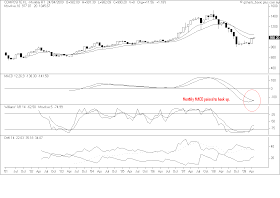In a recent report (via
Phil's Stock World), Merrill Lynch analyst Mary Ann Bartels suggested "L/S HF (that's Long/Short Equity Hedge Funds) market exposure may have peaked in the second half of March, after increasing significantly from the record lows of mid-December.... Quant fund market exposure appears to have peaked in Feb, but started to fall rapidly in late March, a couple of weeks into the current equity rally". See the table below.

The above is significant for two reasons. According to the report, "First, a sharp fall in beta could be a contrarian bullish for equities if HFs are forced back in. Secondly, HFs are an important source of liquidity for the markets - particularly true of quant funds employing high-frequency algorithmic and programming trading strategies. A big drop in HF presence in the equity markets could result in rising volatility."
This was also highlighted by Zero Hedge in a post entitled "
The Incredibly Shrinking Market Liquidity, Or the Upcoming Black Swan of Black Swans," "Anyone who is doing anything sensible right now is either losing money or is out of the market entirely." This in turn has caused a drop in liquidity in the market- approaching a level that is 6 standard deviations away from the recent norms. This could lead to substantial market dislocations based on previous comparable situations, such as those experienced in October 87, August 2007, or January 2008, according to one quant trader.
Similar observation was made by Barclays Capital analyst Matthew Rothman (via
Clusterstock), who has noted that only one quant manager out of 80 that he has talked to has made money during this rally. "It is fair to say that just about everyone is bewildered and trying to understand when this rally will end," Rothman writes.
Back to Zero Hedge. The vast majority of transactions in the market are not customer driven buy/sell orders, but are in fact high frequency, small block trades that constantly cross between a select few of these same quant funds and program traders. The activities of the quant funds, which are carried out via program trading, is a material component of daily volumes (see the table below). According to the NYSE, last week program trading was 8% higher than the 52 week average, which on almost 4 billion shares is a material increase. Some more program trading statistics: principal trading is running 21% above 52 week average, agency trading is 11% below average, while NYSE weekly volume is running about 9% below 52 on average. So, while the number of quant funds operating in the market has dropped, the volume of trades done by the remaining quant funds has actually increased.

A very interesting point to note is the significant participation by the administration darling, Goldman Sachs (see the table below). Goldman's program trading principal to agency+customer facilitation ratio is a staggering 5x, which is multiples higher than both the second most active program trader and the average ratio of the NYSE, both at or below 1x. Some may see this as a sinister development.

Another point made by Zero Hedge is that the Volume Weighted Average Price of the S&P500 index "indicates that the bulk of the upswing has been done through low volume buying on the margin and from overnight gaps in afterhours market trading. The VWAP of the SPY through yesterday indicated that the real price of the S&P 500 would be roughly 60 points lower, or about 782, if the low volume marginal transactions had been netted out. And yet the market keeps on rising. This is an additional data point demonstrating that the equity market has reached a point where the transactions on the margin are all that matter as the core volume/liquidity providers slowly disappear one by one through ongoing deleveraging."
All the above raised serious concern about the sustainability of the current rally. As pointed out by
Seeking Alpha, the "rally" could simply be explained by technical factor driven capital-liquidity aberrations- which will continue at most for mere weeks if not days- instead of a rebound in fundamentals in what has all of a sudden become a V-shaped recovery.

























































